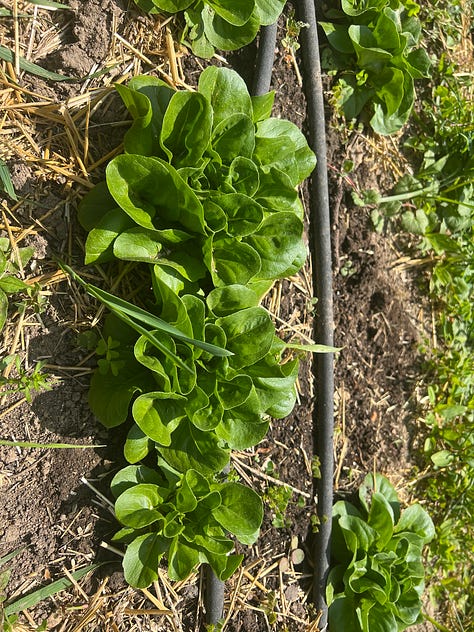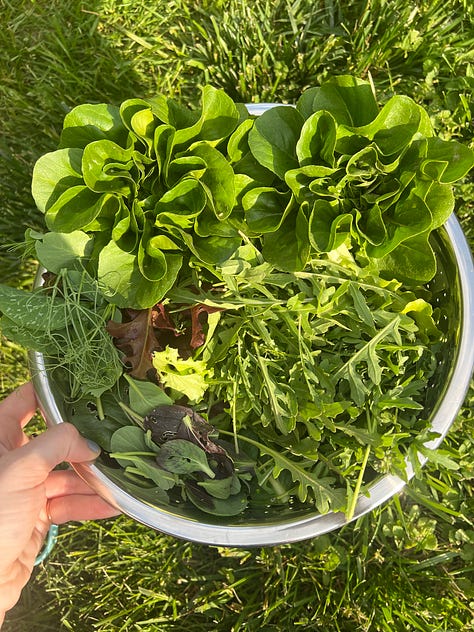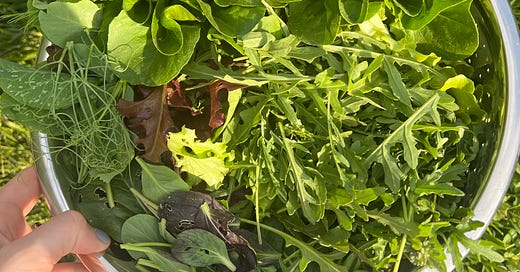Hello from my childhood home in Eastern Pennsylvania, where I can hear the house wren warbling and yeasted Belgian waffle dough is straining for escape against the plastic wrap on the counter. Welcome to the hundreds of you who have embraced Bite into this in the last week. I’m delighted (and a bit terrified) that so many of you are here.
“There’s more enthusiasm for eating here than there is for cooking.”
That’s my dad, after I told him that I would be writing today’s edition of Bite into this about how every time I turn around in the kitchen, I find myself facing the ghosts of my childhood. I wanted to explain how I became this person who spends her weekends writing about cooking, but of course he had to remind me that I don’t actually cook when I come home.
Yet that’s the point. I’m obsessive about home cooking, seasonal produce, and intense flavors. I adore cookbooks. I think Julia Child1 will never go out of style. I keep a kitchen supplied enough to make delicious meals without a trip to the store. I believe everyone should know how to cook and how to really eat and how to feed your people, and none of that should be a burden. All because when I come home, I don’t have to cook, and I don’t want to. My parents believe all of these things, too — and they do it better than me.
So today, veering a bit from our regular programming of recipes or rants, I’m going to tell you about my family and my kitchen ghosts. Hopefully by the end of it, you’ll better understand what brought me here. And if you’d rather just make a strawberry rhubarb pie or get some encouragement to splurge on Le Creuset, those links will take you there.
Friday morning, I walked into my parent’s house and went straight to the fridge. I stared at Ball jars of mysterious sauces, mounds of eggs, strawberries, a tupperware container of bread dough — and sighed. And then my dad’s voice drifted from upstairs, where he could apparently hear me opening and closing the fridge a couple of times.
“You’re looking for food! There’s lasagna in the basement.”
I was looking for food. I can always depend on my parents to have a big container of leftovers tucked away anytime I arrive, to the point that I held off from breakfast on the train up Friday morning. When your parents cook like mine do, leftovers can be more exciting than the original meal.
There was indeed a lasagna in the basement fridge, a white béchamel and cheese, carrot, broccoli, and zucchini lasagna2 my dad’s been making since before I was born, wrapped in plastic wrap and buried under a couple dozen bagels. The fridge almost exploded when I opened it: Here were two racks of ribs, two chickens; over there sat bags of lemons and limes, blocks of parmesan, cheddar, and blue cheese; down one shelf, more quart-sized glass jars gleaming with green and orange concoctions. There were bags of peppers and carrots, herbs and mushrooms. A massive tin of sesame oil. Stacks of tortillas.
My dad calls the basement his corner grocery. We (his children) call it the prepper’s bunker. It’s an unfinished basement, with concrete floors and stone walls and low wooden beams. You can sense that in the late 1700s, the dark and cold and tiny space housed mounds of potatoes and onions. My parents are using it just as it was first intended, only with electric light. You can find multiple types of flour and rice in big plastic tubs. The chest freezer is piled high with frozen quarts of homemade chicken stock, ceci sauce, bolognese, carne asada, and minestrone. There’s not much room to walk.
My parents justify the profligacy with their desire to be able to cook anything on a moment’s notice. They do it, too; for dinner later that evening, we ate grilled ribs and chicken coated in the lemongrass gochujang sauce3 I’d spotted in the fridge, a garden salad (more on that later), white beans stewed with bitter greens, and garlic bread. For breakfast this morning, we had Belgian waffles4 with strawberries. The lasagna is still in reserve, just in case any of the children visiting for the weekend need a nibble after all that feasting.
None of it was planned, per se. Nobody was looking at recipes or working from a grocery list. Discussing dinner with my dad earlier in the day, I vetoed homemade pesto in favor of the beans and greens after walking through the garden, where mustard greens and bok choy were both about to become overgrown with flowers and needed a purpose. The garden salad, too, was a last minute decision, because I couldn’t resist the petite, curly, glossy heads of butter lettuce pushing from the earth and bushy arugula in the next row.



The picture I’m painting is a bit fantastical. But it’s also my reality. It’s the product of a very nerdy boy with very big glasses, who made cooking his hobby at the age of ten after climbing on the counter to read the ancient French cookbooks from Escoffier5 and Elizabeth David6 in his mother’s kitchen. It’s the product of a girl who grew up in a New York Jewish family, where there’s no “enough” unless everyone has four times the amount they can eat and a big slab of lox dripping with golden fat every weekend. After more than a quarter century together, those food histories that made my parents who they were before they knew each other have melded and oozed and expanded to become one. The one that is my food history.
Those cookbooks still sit on the shelf in the kitchen, the covers fading, the spines long gone, the pages still turned even though my dad might know some of them by heart. Other bookshelves house the complete Gourmet magazine collections from a large swath of the 20th century. In one of my earliest memories, I can recall “helping” jar multi-gallon vats of cucumbers that would one day be pickles. I can still picture the clear jugs, untouched, mustard seeds and dill fronds floating among the glowing green cucumbers for weeks on a shelf in the little basement, gathering dust as I watched and wished we could unseal them.
The garden I wandered through with my dad on Friday is a replica of the garden we had when I was small. For a decade between then and now, the beds were allowed to overgrow and then disappear completely, eventually covered entirely with lawn, lost to the emotional and financial stresses that made my family turn inward for a time. I cannot remember exactly when my parents first re-tore through the grass to dig beds for tomatoes once more — maybe five years ago? The beds and dirt and trellises have encroached outward onto the grass more each year since then; last year, they added creeping vines of miniature sugar melons, this year two plots of strawberries. The returned energy of our family can be seen in the growth of the garden and the smoothly-oiled machine of the kitchen. As I write this, I’m realizing that my regard for seasonal produce in the kitchen runs from a deeper well than just love of great flavors. There’s happiness bleeding through the connection between kitchen and garden.
(My youngest brother, studying sustainable agriculture in college now, could write the same version of this story from the perspective of a gardener, if that proves my point.)
We are the product of our food history. Mine is almost disgustingly romantic, while many are not so lucky. Yours might be a dark one, where no one cooked for you or was able to or could afford its cost. You might be one of my unfortunate friends whose moms were so dedicated to starving themselves that they ruined your love of food before you could find it.
You don’t have to embrace all of your history, of course. Better to cherish the good childhood kitchen ghosts if you have them, and then otherwise make new ones that will haunt you later in life.

I’m skipping the restaurant recommendations that usually end this newsletter because today, instead, we have footnotes! If you’re curious about any of the cookbooks I mentioned above, here’s where you can learn more.
Mastering the Art of French Cooking: Volume 1. (And here’s the cheaper Amazon link). Will definitely be the next book I buy myself. If you’ve never read My Life in France, her food writing will put mine to shame. If you’ve never watched Julie and Julia, that is sad for you (and it’s on Netflix right now).
From Marcella’s Italian Kitchen, which is out of print but can be purchased used for $5 or $6 on Better World Books or Thriftbooks. If you don’t own anything by Hazan, your first purchase should probably be The Essentials of Classic Italian Cooking, which will absolutely be the subject of a future newsletter.
From Korean BBQ: Master Your Grill in Seven Sauces, by Bill Kim and Chandra Ram. I keep at least two of these sauces in my fridge at all times. (Here’s the same book much cheaper on Amazon, but I like to suggest the independent book-buying option if you can afford it).
From the 2006 anniversary edition of the Joy of Cooking. The 1997, 2006, and 2019 versions are all quite different in terms of style, but any one of them could be great to start with. I hear the 2019 is a bit overloaded with more “modern” recipes, so if you’re interested in the classics maybe stick with one of the older editions.
The man who helped make those French mother sauces iconic, the Escoffier Cookbook.




Love footnotes! And I'm glad you're going with the class JOY OF COOKING (2006). The story of that cookbook itself is worthy of an entry. Hint, hint -- otherwise known as a writing prompt from a teacher who just can't quit. Bite into this is great!